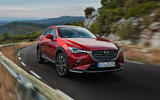What is it?
A revised take on the supermini-sized, sort-of SUV, one that Mazda hopes will put some distance between the Mazda Mazda CX-3 and a constantly expanding field of competitors.
When it arrived in 2015, Mazda's competent crossover was something of a jack of all trades. It looked the part, drove well and was fairly economical, but didn’t really excel in any one area at a time when various rivals were championing practicality, value, and sheer niche appeal.
That’s set to change with this facelifted Mazda CX-3, which has received a slew of mechanical upgrades in addition to visual tweaks and interior additions.
New coil springs and dampers have been fitted to the MacPherson strut front and torsion beam rear suspension to sharpen the handling, the electric power steering has been retuned to be more responsive and the size of the front stabiliser has been reduced to improve roll response. So more than just a prettier face, then.
It’s also the first model to get Mazda’s new 1.8-litre Skyactiv-D diesel engine, which replaces the 1.5-litre unit found in the outgoing model. Efficiency boosts come courtesy of revised multi-stage injectors and egg-shaped pistons, which make for better combustion. However, with 85% of UK customers opting for the petrol derivative, we’ve concentrated on that instead.
The 2.0-litre, four cylinder unit is available in either 119bhp or 148bhp outputs, and can be mated to a six-speed manual or an automatic gearbox. It’s tested here in its entry-level potency, combined with the automatic 'box.
In the UK, the petrol CX-3 can also be equipped with four-wheel drive, but front-drive models like our test subject will almost certainly be the bigger sellers.
















































Join the debate
Add your comment
The 2nd generation CX-3 due
The 2nd generation CX-3 due to arrive within 24 months will finally address the lack of rear people/boot space and should match or better rivals.